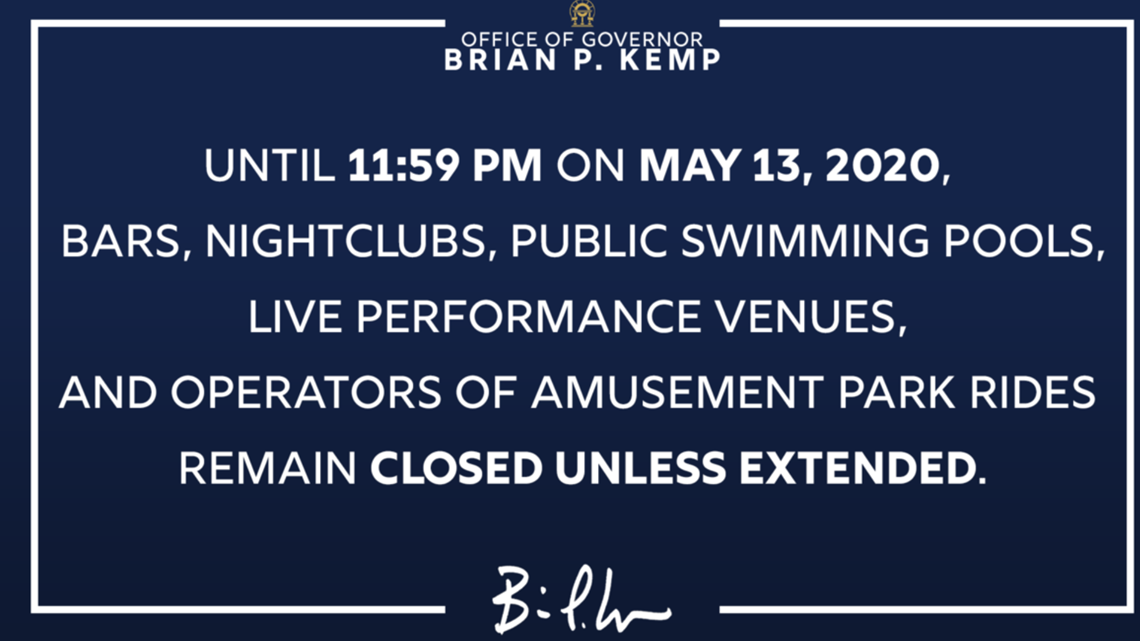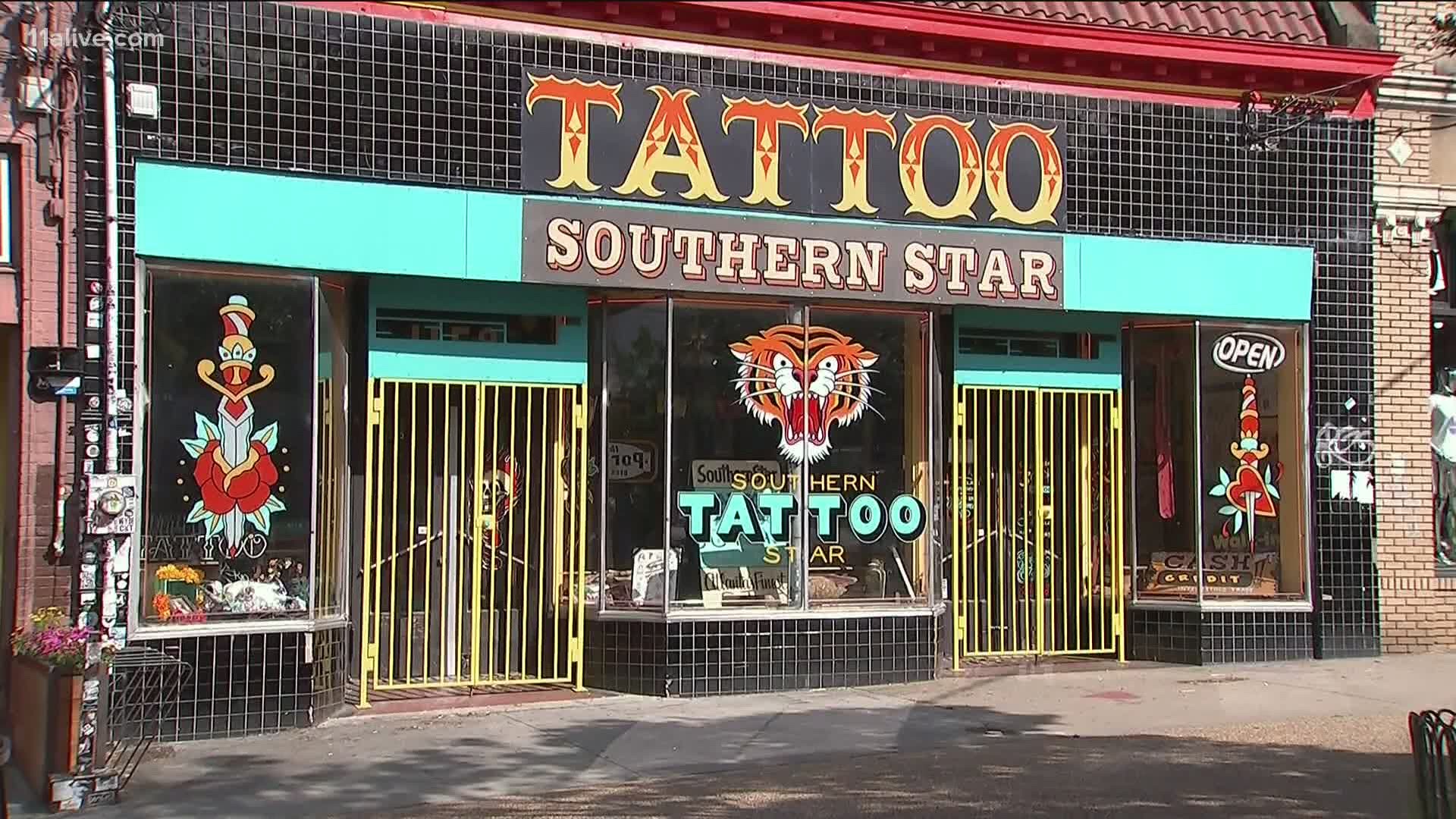ATLANTA — Bars and nightclubs are among those operations that will stay closed until May 14 under Gov. Brian Kemp's executive order issued Thursday.
The governor also cautions that the requirement they stay shut may be extended.
In a release, the governor's office included a graphic that said until 11:59 p.m. on May 13 "bars, nightclubs, public swimming pools, live performance venues, and operators of amusement park rides remain closed unless extended."


Those are the last specific businesses in Georgia that have remained closed after the governor began lifting restrictions on others - such as salons and restaurants - in the last week.
Kemp's latest order extended the public health state of emergency and a shelter-in-place for the medically fragile and elderly until June 12.
He also extended an executive order outlining special protocalls for nursing homes and senior living facilities and another order authorizing the National Guard to assist in the COVID-19 response.
If bars and nightclubs are allowed to reopen after May 13, they will likely face a long list of requirements to meet to be able to operate.
See the governor's full order below:
For restaurants that have already opened, they must comply with a list of 39 restrictions issued by the governor.
Those include:
- Screen and evaluate workers who exhibit signs of illness, such as a fever over 100.4 degrees Fahrenheit. Or if they have a cough or shortness of breath.
- Require employees who exhibit signs of illness to not report to work or to seek medical attention. An employee who has or is suspected of having COVID-19 must follow the CDC guidelines to self isolate for at least seven days after symptoms onset. You can end isolation only after symptoms have improved and the fever has been gone for at least three consecutive days.
- Implement teleworking for all possible workers.
- Implement staggered shifts for all possible workers.
- Hold meetings and conferences virtually when possible.
- Train employees on the importance and expectations of frequent hand-washing and the use of hand sanitizers will at least 60 percent alcohol. Provide instruction for them to avoid touching their face.
- Require employees to wear face coverings. The coverings need to be cleaned or replaced daily.
- Discourage workers from using other workers' phones, desks, offices, or other work tools and equipment.
- Where possible, stagger work stations to avoid employees from standing adjacent to one another or next to each other. When six feet of separation is not possible, consider spacing options that include other mitigation efforts with increased frequency of cleaning and sanitizing surfaces.
- Establish limit numbers to reduce contact in employee break rooms.
- Prohibit handshaking and other unnecessary person-to-person contact in the workplace.
- Enforce social distancing of non-cohabitating people while present on such entity's leased or owned property.
- Increase physical space between workers and patrons.
- Discard all food items that are out of date.
- Discontinue use of salad bars and buffets.
- If providing "grab-and-go" service, stock cookers to no more than minimum levels.
- Ensure Food Safety Manager certification of the person in charge is up-to-date; provide food handler training to refresh employees.
- Thoroughly detail, clean, and sanitize the entire facility prior to resuming dine-in services and continue to do so regularly, focusing on cleaning and sanitation on high contact areas.
- Between diners, clean and sanitize table condiments, digital ordering devices, check presenters, self-service areas, tabletops, and commonly touched areas, and discarding single-use items.
- Use rolled silverware and eliminate table presets.
- Remove items from self-service drink, condiment, utensil, and tableware stations and have workers provide such items to patrons directly wherever practicable.
- The use of disposable paper menus is strongly encouraged, which should be discarded after each patron use. Otherwise, businesses (subject to this section in the order) should clean and sanitize reusable menus between each use by a patron. Non-touch menus are also acceptable.
- Clean and sanitize restrooms regularly and check restrooms based on the frequency of use. Ensure the adequate supply of soap and paper towels at all times.
- Implement procedures to increase cleaning and sanitizing frequency of surfaces in the back-of-house. Avoid all food contact surfaces when using disinfectants.
- Update floor plans for common dining areas residing seating arrangements to ensure that at least six feet of separation from seating to seating. Use physical barriers on booth seating when available.
- Limit party size at tables to no more than six people.
- Where practical, consider a reservations-only business model or call-ahead seating.
- Remind third-party delivery drivers and any suppliers of your internal distancing requirements.
- Post signs on entrances that no one with a fever or symptoms of COVID-19 is permitted in the facility.
- Where practicable, physical barriers such as partitions or plexiglass at registers should be used.
- Use tech solutions where possible to reduce person-to-person interaction: mobile ordering, mobile access to menus to plan in advance, text on arrival for seating, and contactless payment options.
- Provide hand sanitizer for use by patrons, including contactless hand sanitizing stations when available.
- Do not allow patrons to congregate in waiting areas or bar areas. Design a process to ensure patron separation while waiting to be seated that can include floor markings, outdoor distancing, or waiting in cars.
- If possible, use an exit from the facility separate from the entrance.
- Mark ingress/egress to and from restrooms to establish paths that mitigate proximity for patrons and staff.
- Where practicable, takeout and curbside pick-up services should be prioritized over dine-in services.
- All restaurant or dining room playgrounds shall be closed.
11Alive is focusing our news coverage on the facts and not the fear around the virus. We want to keep you informed about the latest developments while ensuring that we deliver confirmed, factual information.
We will track the most important coronavirus elements relating to Georgia on this page. Refresh often for new information.
MORE CORONAVIRUS HEADLINES

